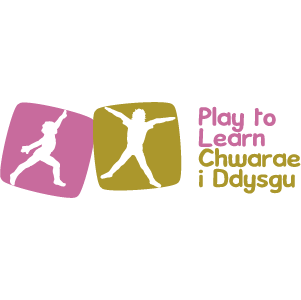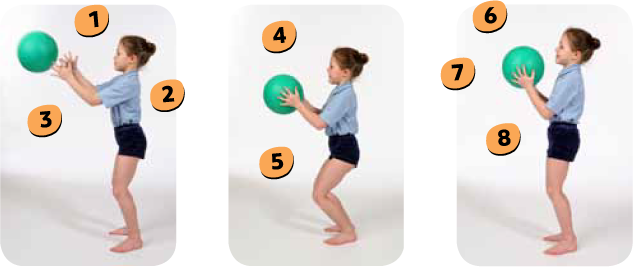
Instructions
Catching is receiving an object with hands. It involves the child visually tracking the object in flight and moving into a position to collect the object safely without dropping it. Catching is important in many major games, e.g. cricket, baseball, rounders, netball, basketball and rugby.
- Watch the object
- Move the body so that it is in line with the object
- Reach the arms and hands towards the object
- Watch the object and adjust hands to catch it
- Present a large surface area in the ‘ready’ position (fingers spread and soft, hands in cup formation)
- Catch the object in hands only – do not use the chest to secure an object
- Hands and fingers close around the object
- Receive with some give in the hands and arms, bringing the object close to the body

Safety
Ensure…
- children’s fingers are warm before attempting to catch an object
Opportunity to develop
- Co-ordination
- Control
- Manipulative and motor skills
Physical Development Area of Learning
- contributes to ‘Personal’ and ‘Adventurous and physical play skills’ section
If you see
| Observation | Likely Cause | Solution |
|---|---|---|
| ‘Flaps’ or grabs at the object | Scared of the object, or eyes are closed | Watch the object into hands. Keep eyes on the object. Use balloons / beach ball to build up confidence. |
| Moves away from the object, puts hands up to protect face | Avoidance reaction: the child moves to protect their face | Explore balloons / beach objects to build up confidence |
| Catches the object into the body – ‘scoops’ or ‘cradles’ the object | Catches the object with the body and the palms of the hands face upwards | Use a balloon to successfully catch in hands |
| Misses the object | Hands are not held out in the ‘ready’ position. Not watching object. | Start with hands out in ‘ready’ position in front of body, little fingers close together, palms facing each other and fingers pointing slightly to the ground |
| Bounces out of child’s hands | Does not ‘cushion’ the ball on catching | Bring ball into body after catching |
| Responds slowly to the ball and misses the catch | Hands are too far apart | Feel the ball before catching it and keep hands in that shape/size ready to catch |
Can you see?
- the child’s feet moving in line with the object?
- the child showing they can track the object?
- the child’s head staying still and the child watching the object?
- the child reaching out with their hands to the object?
- the child’s hands adjusting to the path and size of the object?
- the child catching the object in their fingers?
- the child bringing the object into their body following the catch?
- the child successfully holding the object and maintaining balance?
-
Mostly No
- Blow bubbles or use a balloon so that children experience following and tracking an object.
- Throw a balloon in the air and ask children to track the balloon and try to stop it hitting the floor by patting with both hands to keep in the air. Throw a balloon and attempt to catch it. Throw a balloon to a partner 2–3 metres away and catch it.
- Throw a coloured scarf into the air and catch it on a part of the body, such as hand, head, foot or back.
- Bounce a large ball to self and catch it after one bounce.
- Practise catching a soft ball, ‘cupping’ hands under the ball.
- Pass a ball from hand to hand, around the body.
- Practitioner rolls a large ball sympathetically along a table. Child stands at the end and catches the ball when it falls.
- Stand and face partner and give bean bag to partner, then try with a ball.
-
Yes and No
- Practise ‘M’ formation, little fingers together, fingers pointing to the floor, hands underneath the ball for catches waist height and below
- Sympathetic feed from practitioner – catch balls of different shapes, colours and sizes
- Throw a scarf to a partner to catch
- Throw a bean bag into the air and catch
- Practitioner throws a bean bag for a child to catch – gradually increase the space in between thrower’s and catcher’s hands
- Throw a variety of balls sympathetically (either practitioner or a more skilful child) for a child to catch
- Practise with different sized, coloured balls
-
Mostly Yes
- Practise ‘W’ formation, thumbs together, fingers pointing upwards, hands behind the ball for catches above waist height
- Catch a ball over a greater distance
- Catch a ball that is high or low
- Throw a ball against a wall and then catch the rebound
- Move backwards/forwards/left/right to catch a ball
- Catch a smaller ball
- Catch a ball thrown at different levels – high, low
-
Challenge
- Catch a ball standing on a line, on a beam, on a wobble spot
- Catch a ball thrown to your knees, above your head, away from your body, close to your body
- Catch a ball as above only using one hand to catch
- Catch and throw between you and your partner
- Catch and throw two balls alternately and simultaneously between you and your partner; vary the ways you can do this
- Catch a ball dropped by your partner before it touches the ground
- Stand in wide ready position, hold a ball between your legs one hand front one back drop and catch the ball, switch hands to catch, with a bounce / without a bounce
- Catch using any combination of the above from a wobble spot, using a variety of balls, using both hands alternately
- Catch a ball in response to a range of cues, using both hands
- Combine dribbling with hands, bouncing, catching, throwing and fast feet in response to a range of cues, following a range of pathways


